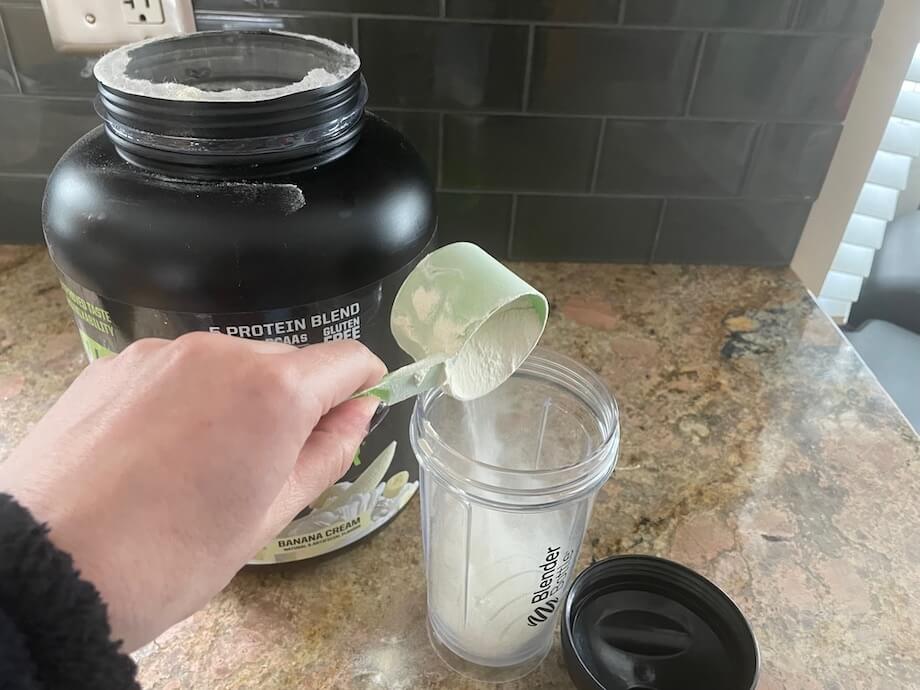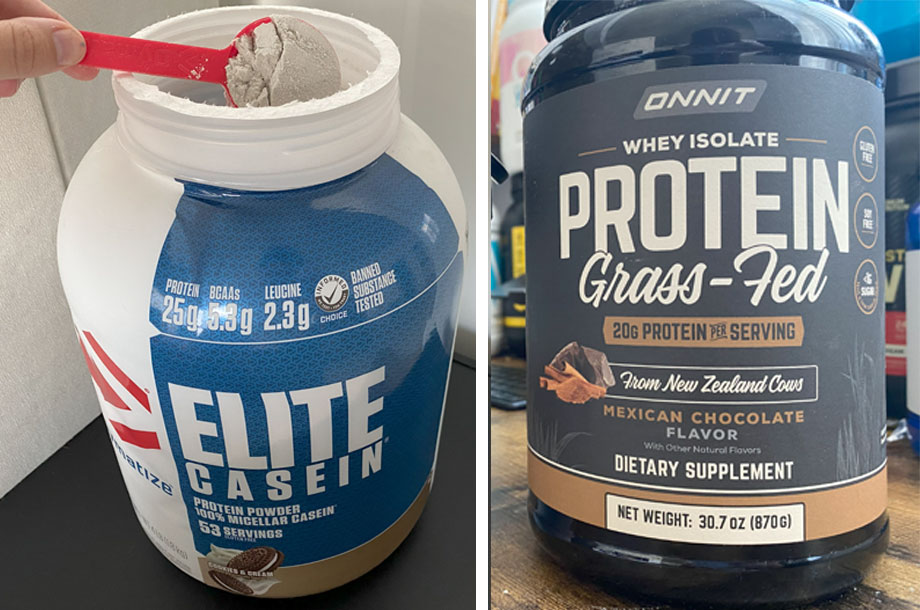If you’ve been in a gym, you’ve probably heard people’s opinions on the best protein powders on the market and which ones should be in your supplement stack. Of the many protein options available, whey protein is one of the most popular supplements out there. Nevertheless, one lesser-known protein powder is on the rise: whey’s close counterpart, casein protein.
So, when it comes to casein protein vs whey protein, which protein source is best for your goals? I spoke with USA Weightlifting’s sports dietitian, Meagan O’Connor, RD, about these two proteins and their benefits. What I discovered is that the answer to which protein is best for you isn’t clear-cut. It largely depends on your goals and what you want from your protein supplement.
Let’s go ahead and dive into these proteins and discuss their similarities and differences.
Medical disclaimer: This article is intended for educational and informational purposes only. It is not intended as a substitute for medical advice. For health advice, contact a licensed healthcare provider.
What are Casein and Whey Protein?
The most obvious similarity between these two protein powders is that both casein protein and whey protein are derived from cow’s milk. When acids and enzymes are added to milk in the cheesemaking process, milk is separated into solid curds and liquid whey.
RELATED: What is Casein Protein?

The curds are made from particles of casein protein called micelles that aggregate together and separate from the liquid whey. Casein is the most abundant protein source in milk1 (about 80% of the total protein content), with a smaller percentage coming from whey (20%). The solid curds can be used in dairy products like cottage cheese or cheese curds, or they can be further processed into powder form, making micellar casein protein powder.
The liquid milk protein—whey—is separated from fats and water and then dried to form whey protein powder. Whey protein is probably the most popular protein powder on the market today and comes in three different types of protein:
- Whey protein isolate has been processed to optimize the amount of protein and minimize fats, lactose, and other byproducts. Whey isolate contains at least 90% protein2.
- Whey protein concentrate is not as processed as whey isolate and will therefore have more fat and lactose within the protein.
- Whey protein hydrolysate is partially broken down during processing through hydrolysis. This will make the fast-acting protein easier to digest, which is ideal for those who suffer from digestive issues or train frequently throughout the day.
RELATED: What is Whey Protein?
Both casein and whey have a strong amino acid profile and are considered complete proteins, meaning they contain all nine essential amino acids. These essential amino acids are necessary to any diet, as these amino acids aren’t naturally produced by the human body.
Similarities and Differences of Whey Vs Casein
Now that we know how the best whey protein and casein protein are derived from the same source: let’s look at how these protein supplements differ. Most of the differences between these two proteins come from their starting state; casein starts off as solid curds, while whey is a liquid.
Different Absorption Rates
Because of its starting state as a liquid, whey protein has a faster absorption rate than casein. In a 2016 study3, greater amounts of branched-chain amino acids were available for absorption at 30 minutes, 60 minutes, and 90 minutes post-workout when whey was consumed than when using casein or soy protein. This often makes it a popular choice for post-workout protein shakes.
RELATED: Taking Protein After a Workout
Casein is a slow-digesting protein. It starts as a solid and reforms into solids during the digestion process, slowing down its total absorption time. This isn’t necessarily a bad thing, though, as it can help supply protein over an extended period.
Casein is a popular protein to have before bedtime, as it releases more protein to your body while you’re sleeping. A June 2020 review4 remarks on how casein before bed can help improve muscle protein synthesis, as well as improve muscle recovery and reduce muscle soreness.
Mixing Well…Or Not So Well

Whey mixes well with water and liquid due to its fast absorption and digestion rate. Therefore, it is great to mix with the best protein shakes when you’re on the go. Casein, on the other hand, is thicker and doesn’t break down as easily, not mixing as well. It can be used for shakes, of course, but it may need a bit more stirring to fully mix. It’s also a great protein powder for protein pudding and mixing into other recipes.
RELATED: How To Use Protein Powder
Satiety
Out of the three macronutrients—proteins, fats, and carbohydrates—protein provides more satiety than the other two macros, according to a review by the American Journal of Clinical Nutrition5. Although you may think that casein would add to the feeling of fullness, there doesn’t seem to be any difference between these milk proteins.
A 2009 trial6 showed that satiety ratings appeared similar between three types of protein tested: whey, casein, and soy. It appears that protein will give you that full feeling, regardless of type, although the study also showed that whey protein affects hormonal changes (like insulin) more than casein or soy.
Amino Acid Profiles
Although both milk proteins have all essential amino acids, the amount of BCAAs differs in casein and whey protein.
A 2019 study7 explored the profiles of these two proteins and showed the exact amounts of amino acid availability of each protein type. Casein has a higher amount of glutamine, an amino acid that supports immune function8 and can aid in muscle recovery. Furthermore, whey protein was shown to have higher amounts of the essential amino acids leucine and isoleucine, which are catalysts for muscle protein synthesis7—or building muscle.
RELATED: Benefits of Glutamine
Price
While both casein and whey have great benefits for building muscle and maintaining lean muscle mass during weight loss (listed below), one thing they don’t share is the price. Casein protein powder tends to be pricier than whey protein, although it will depend on the brand. This is another reason why whey protein is a more popular option.
Benefits of Casein and Whey Protein
There are many health benefits to casein and whey protein, and many of those benefits overlap. Still, there are differences between these proteins’ benefits that are noteworthy.
Muscle Growth & Maintenance
One of the most well-known benefits of protein powder is its help building muscle and maintaining lean muscle mass. Whey and casein help in both building and maintaining muscle mass during fat loss or weight loss. However, their absorption rates do make them a little better in certain areas.
Whey is often considered anabolic, meaning it helps build muscle. This is usually why whey is popular amongst bodybuilders and lifters for post-workout consumption, when muscles need to be replenished of amino acids and quickly. A 2009 study9 showed that whey protein taken after resistance training drastically improved muscle protein synthesis than either soy or casein protein.
Casein tends to have more anti-catabolic properties, which means it can improve muscle mass maintenance and prevent muscle tissue breakdown. The slow release of casein protein helps produce a steady stream of amino acids to the body over a longer period, aiding in muscle recovery and soreness.
Sports dietitian Meagan O’Connor points out, though, while both might have their individual strengths, casein and whey can help in both muscle-building and muscle recovery. She says, “They both are complete protein sources and, therefore, they are both anabolic and anti-catabolic.”
Still, because of their unique properties, Meagan recommends, if you’re taking both, to have whey post-workout to replenish your muscles and casein about an hour before bed to help with maintenance and repair.

Nutritional Benefits
The nutritional makeup of casein and whey differs as well, providing unique benefits to you.
First, casein contains bioactive peptides10 that can help the immune system and the digestive systems, improving gut health. Some of these bioactive peptides can help lower blood pressure or lessen the formation of blood clots11.
The nutritional benefits of whey protein start with an abundance of immunoglobulins, which help boost the immune system. These immunoglobulins are known to have antimicrobial properties12, slowing the growth of harmful microbes like bacteria or viruses. Additionally, whey has tons of antioxidants, which can help reduce inflammation13 from stress and other factors.
Getting Enough Protein
Whether you’re an athlete trying to build muscle through resistance exercise and diet or you’re a fitness enthusiast tracking fats, carbs, and protein—it’s important to meet your daily protein goals. Studies have shown14 that getting enough protein throughout the day is one of the biggest factors in getting the most benefit from protein supplementation. Both whey and casein protein powder are quick and easy ways to boost your protein intake for the day.
RELATED: How to Get More Protein
It’s important to note that protein powder should supplement your protein intake, not the other way around. Make sure to get the majority of your protein from nutrient-rich whole foods.
RELATED: How Much Protein Do I Need?
Possible Side Effects
While protein powder is a relatively safe supplement, there are a couple of things to look out for. The main thing to note with both casein and whey protein is that they are derived from milk. Therefore, anyone with a dairy allergy should avoid these proteins, and perhaps consider a plant-based or vegan protein powder.
Also, those with lactose sensitivity may encounter digestive issues with casein or whey protein, like stomach pain, bloating, or diarrhea. However, fast-acting whey, like whey isolate or whey hydrolysate, might be enough to avoid gastrointestinal issues.
RELATED: Best Protein Powder for Sensitive Stomachs
Of course, if you have any kidney or liver issues, it’s best to talk to your doctor before taking a protein supplement—or any supplement, for that matter.
When to Take Casein or Whey Protein
There’s no real wrong time to take either casein or whey protein, although Meagan stresses that there are optimal times to take each. Because of their differing absorption times, she recommends, “It’s best to replenish protein broken down during training with whey protein. Then, have casein protein about an hour before bed for a constant stream of amino acids while you sleep to repair and recover.”
Some people will mix the two proteins together to get the quick spike of aminos through whey, followed by the slow release of casein. Also, some protein blends have both types of protein. Meagan says it’s fine to mix the proteins together, but there’s no real added benefit from it. She’s had people do it before, if they finished training and weren’t going to be able to eat for a while, but the instances where it’d be really helpful are rare in most cases.

Casein Protein Vs Whey: Final Thoughts
While coming from the same dairy source, casein protein and whey protein are able to benefit athletes, bodybuilders, and fitness fanatics alike through their unique amino profile. Here are some main takeaways on these two proteins’ similarities and differences:
- Both whey and casein protein are derived from milk, and separated during the cheesemaking process.
- Whey protein has a much faster absorption rate, making it ideal for a post-workout drink to help replenish amino acids.
- Casein is a slow-digesting protein, which means it can help prevent muscle breakdown and enhance muscle recovery when taken before bed.
- While these proteins can be taken at any time during the day, there are optimal uses for each of these protein supplements.
- Both casein and whey protein are great sources of extra protein to meet daily protein goals. However, the majority of protein requirements should come from high-protein foods.
Casein Protein Vs Whey: FAQs
Is casein better than whey protein?
Whether or not casein protein is better than whey will depend entirely on your fitness goals and needs. The main difference between the two proteins is the absorption rate: whey is absorbed much faster than slow-digesting casein protein.
Neither dietary protein is good or bad, but in comparing these two, whey is the best protein to have post-workout when you want protein and amino acid levels replenished. Casein is ideal for a slow release of aminos, so it’s typically taken before bed to help muscle recovery during sleep.
Does casein build more muscle than whey?
Both types of proteins are great to help promote muscle growth and are complete proteins; however, whey protein has an abundance of the amino acids leucine and isoleucine, which are catalysts for muscle protein synthesis, or building muscle7. This means whey may be able to help build more muscle, although it’s inconclusive if whey protein has a long-term effect on muscle-building.
Casein, on the other hand, has been shown to have a higher amount of glutamine than other protein powder sources, which is used for immune function and has been shown to aid in muscle recovery and soreness (although further research is needed). Research4 shows that taking casein before sleeping can help improve muscle growth and muscle recovery.
Is casein more expensive than whey?
Generally, casein protein powder tends to cost more than whey protein powder, although the exact difference will depend on the brand.
These statements have not been evaluated by the Food and Drug Administration. This product is not intended to diagnose, treat, cure, or prevent any diseases.
References
- Davoodi SH, Shahbazi R, Esmaeili S, Sohrabvandi S, Mortazavian A, Jazayeri S, Taslimi A. Health-Related Aspects of Milk Proteins. Iran J Pharm Res. 2016 Summer;15(3):573-591. PMID: 27980594; PMCID: PMC5149046.
- Madureira AR, Pereira CI, Gomes AMP, Pintado ME, Xavier Malcata F. Bovine whey proteins – Overview on their main biological properties. Food Res Int. 2007 Dec;40(10):1197–211. doi: 10.1016/j.foodres.2007.07.005. Epub 2007 Aug 3. PMCID: PMC7126817.
- Kanda A, Nakayama K, Sanbongi C, Nagata M, Ikegami S, Itoh H. Effects of Whey, Caseinate, or Milk Protein Ingestion on Muscle Protein Synthesis after Exercise. Nutrients. 2016 Jun 3;8(6):339. doi: 10.3390/nu8060339. PMID: 27271661; PMCID: PMC4924180.
- Kim J. Pre-sleep casein protein ingestion: new paradigm in post-exercise recovery nutrition. Phys Act Nutr. 2020 Jun 30;24(2):6-10. doi: 10.20463/pan.2020.0009. PMID: 32698256; PMCID: PMC7451833.
- Paddon-Jones D, Westman E, Mattes RD, Wolfe RR, Astrup A, Westerterp-Plantenga M. Protein, weight management, and satiety. Am J Clin Nutr. 2008 May;87(5):1558S-1561S. doi: 10.1093/ajcn/87.5.1558S. PMID: 18469287.
- Veldhorst MA, Nieuwenhuizen AG, Hochstenbach-Waelen A, van Vught AJ, Westerterp KR, Engelen MP, Brummer RJ, Deutz NE, Westerterp-Plantenga MS. Dose-dependent satiating effect of whey relative to casein or soy. Physiol Behav. 2009 Mar 23;96(4-5):675-82. doi: 10.1016/j.physbeh.2009.01.004. PMID: 19385022.
- Liu J, Klebach M, Visser M, Hofman Z. Amino Acid Availability of a Dairy and Vegetable Protein Blend Compared to Single Casein, Whey, Soy, and Pea Proteins: A Double-Blind, Cross-Over Trial. Nutrients. 2019 Nov 1;11(11):2613. doi: 10.3390/nu11112613. PMID: 31683779; PMCID: PMC6893549.
- Cruzat V, Macedo Rogero M, Noel Keane K, Curi R, Newsholme P. Glutamine: Metabolism and Immune Function, Supplementation and Clinical Translation. Nutrients. 2018 Oct 23;10(11):1564. doi: 10.3390/nu10111564. PMID: 30360490; PMCID: PMC6266414.
- Tang JE, Moore DR, Kujbida GW, Tarnopolsky MA, Phillips SM. Ingestion of whey hydrolysate, casein, or soy protein isolate: effects on mixed muscle protein synthesis at rest and following resistance exercise in young men. J Appl Physiol (1985). 2009 Sep;107(3):987-92. doi: 10.1152/japplphysiol.00076.2009. Epub 2009 Jul 9. PMID: 19589961.
- Mohanty DP, Mohapatra S, Misra S, Sahu PS. Milk derived bioactive peptides and their impact on human health – A review. Saudi J Biol Sci. 2016 Sep;23(5):577-83. doi: 10.1016/j.sjbs.2015.06.005. Epub 2015 Jun 17. PMID: 27579006; PMCID: PMC4992109.
- Fekete ÁA, Givens DI, Lovegrove JA. Casein-derived lactotripeptides reduce systolic and diastolic blood pressure in a meta-analysis of randomised clinical trials. Nutrients. 2015 Jan 20;7(1):659-81. doi: 10.3390/nu7010659. PMID: 25608938; PMCID: PMC4303860.
- Moreno-Expósito L, Illescas-Montes R, Melguizo-Rodríguez L, Ruiz C, Ramos-Torrecillas J, de Luna-Bertos E. Multifunctional capacity and therapeutic potential of lactoferrin. Life Sci. 2018 Feb 15;195:61-64. doi: 10.1016/j.lfs.2018.01.002. Epub 2018 Jan 4. PMID: 29307524.
- Zhou LM, Xu JY, Rao CP, Han S, Wan Z, Qin LQ. Effect of whey supplementation on circulating C-reactive protein: a meta-analysis of randomized controlled trials. Nutrients. 2015 Feb 9;7(2):1131-43. doi: 10.3390/nu7021131. PMID: 25671415; PMCID: PMC4344580.
- Wirth J, Hillesheim E, Brennan L. The Role of Protein Intake and its Timing on Body Composition and Muscle Function in Healthy Adults: A Systematic Review and Meta-Analysis of Randomized Controlled Trials. J Nutr. 2020 Jun 1;150(6):1443-1460. doi: 10.1093/jn/nxaa049. PMID: 32232404.







